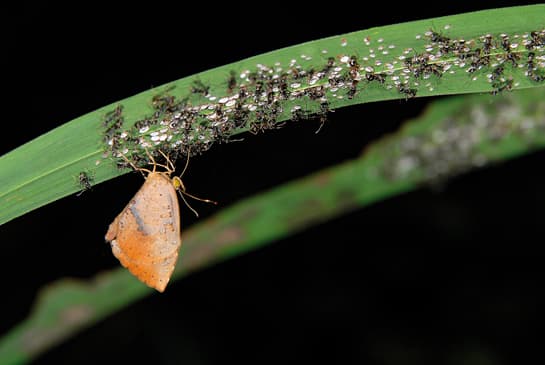On a night walk in the Doyang Valley, Dr. Anish Andheria stumbles upon a rarely recorded phenomenon – a four-party association between three insects belonging to three different orders (Lepidoptera, Hymenoptera and Hemiptera)… and a plant!
 Photo: Dr. Anish Andheria
Photo: Dr. Anish Andheria
I was in the Doyang valley in October 2013, working with several like-minded organisations to campaign against the massacre of Amur Falcons in Nagaland. The passage migrants conglomerate in unimaginable numbers in a narrow stretch of forest. However, the naturalist in me would observe the falcon spectacle by the day and look for other organisms by the night. It was on one such sortie at about 8 p.m. that I stumbled upon the dramatic natural history phenomenon you see on this page.
It’s a quadripartite association between three insects belonging to three different orders (Lepidoptera, Hymenoptera and Hemiptera)… and a plant!
Ants are omnivorous, feeding on animals and grains. They far outnumber their potential insect prey. This is counter-intuitive, as normally one would reasonably expect that prey species would outnumber predators.
The answer to the contradiction lies in a series of symbiotic relationships that the ants enjoy. One among these involves Hemipterans, which includes scale insects, aphids and mealy bugs. That is what you see here on this page. The scale insects are taking their own food from the grass blade and passing some of it to the ants in the form of a nutritious honeydew, made up of sugar and amino acids. The ants, in return, protect their benefactors from predators such as wasps, birds and flies. Most plants protect themselves using chemicals to dissuade leaf-chewing herbivores. The scale insects are able to overcome those chemical defenses, and the ants are thereby able to access nutrients that would not normally be available to them.
This is interesting, but even more fascinating is the fact that the common brownie butterfly Miletus chinensis assamensis manages to steal honeydew notwithstanding the presence of the ants that would readily attack any animal that approaches the scale insects or the leaf. In nature, to survive, all lifeforms must find a way, or die out.
This association between the butterfly and the ants is a potential form of kleptoparasitism where one animal steals food from another that has caught or collected it. This has rarely been documented in the wild. To understand the phenomenon, one needs to delve into the life-cycle of the common brownie butterfly, one of the 520+ species of Lycaenid butterflies found in India. Most have evolved symbiotic relationships with ants. Their caterpillars possess special glands that also secrete a nectar-like substance (honeydew) to attract ants, which consume this secretion and, in return, protect them from predators. In fact, this secretion is not merely nutritious, but also contains chemicals that subdue the ants, which might otherwise attack the caterpillars themselves! The ants also act as deterrent to predators including birds, tree frogs and the like.
The ants benefit from the food provided by the caterpillars. The caterpillars benefit from the ants’ protection. As for the adult butterfly it probably utilises a pheromone retained from its larval stage, that seems to dissuade the ants, which would normally attack and eat any invading insect. Symbiosis has played a significant role in carving the path of evolution of living systems. What we see at play in this image is an intricate web of associations that delivers a win-win-win-win for all species involved.
First published in: Sanctuary Asia, Vol. XXXVIII No. 10, October 2018.
——————————————————————————————————————————————————————
About the Author: Dr. Anish Andheria, a conservation biologist, naturalist and wildlife photographer, is the President of the Wildlife Conservation Trust, a not for profit working in and around 160 Protected Areas in 23 Indian states to safeguard natural ecosystems by strengthening the protection mechanism of forests and building capacity in local communities.
——————————————————————————————————————————————————————
Disclaimer: The author is associated with Wildlife Conservation Trust. The views and opinions expressed in the article are his own and do not necessarily reflect the views and opinions of Wildlife Conservation Trust.
Related Links
- Man’s best friend, wildlife’s NEW foe!
- Media
- Donors
- Should Art Kill Its Muse?
- In Praise of the Ghost Tree
